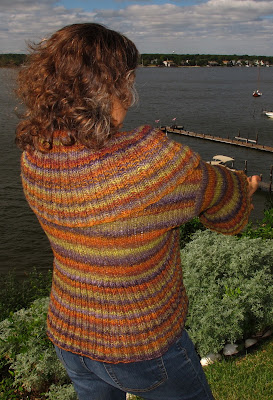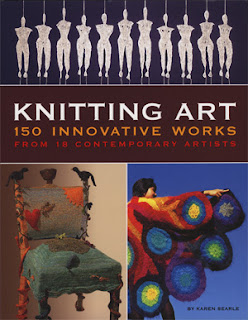Once a week I post interviews with interesting designers about their insights on their experience of working in the Knitting industry. I’ve noticed that every designer makes their living in a slightly different manner bringing their own unique presence to the Knitting world.
All Photography (c) by John Gruen, from Toe-Up 2-at-a-Time Socks by Melissa Morgan-Oakes, used with permission from Storey Publishing.
Where do you find inspiration?
I find inspiration everywhere. We live in a pretty rural setting and I find nature to be particularly inspiring, but I am also fascinated by more urban settings as well. Really, life inspires me!
What are your favourite knitting and crocheting techniques?
I adore cables. The texture and the light and shadow they catch when done in just the right yarn makes me a little giddy. And although I am known as a knitter, I learned to crochet first and have always had a fondness for broomstick lace.
How did you determine your size range?
For the most part I rely on Craft Yarn Council (http://www.craftyarncouncil.com/sizing.html) standards in determining the size of a specific garment. I try to be as inclusive as possible and like to offer options. My objective is to try to create a minimum of five sizes for garments and two for socks. Sometimes that’s reasonable and other times it is not.
Do you look at other designers' work or are you afraid that you will be influenced by their designs?
I peruse others work in the form of magazines and books the same way any knitter does, but I don’t intently study it. The exception to this would be Elizabeth Zimmermann whose work I will cheerfully immerse myself in deeply and regularly. Even when knitting for myself I tend to design rather than use someone else’s pattern, or I will modify an existing pattern significantly. It’s important to stay abreast of trends, and you can’t really do that without looking around you a bit at what others are doing.
How do you feel about the so called controversy of "dumbing down" patterns for knitters and crocheters?
Not every person who bakes wants to bake and decorate a 12-layer wedding cake from scratch. And not every person who bakes uses a boxed mix, either. Neither is better than the other, they just have different goals and approaches. As long as both of them are satisfied at the end of the day, it really doesn’t matter. I don’t think it’s ‘dumbing down’ a pattern to work to make it achievable and desirable by the mainstream. I think there needs to be a wide range of patterns in a wide range of skill levels. I think those skill levels need to be clearly stated on the pattern, and I think knitters need to be realistic and honest about their proficiency when choosing a pattern.
How many sample/test knitters and crocheters do you have working for you or do you do it all yourself?
Right now I have five or six people that I rely on to help with sample and test knitting. When I am working on a single project it’s a little easier to knit it all myself, but larger projects like a book require a more intense approach. Although I would love to knit them all myself - and in the first book I did knit over half before conceding defeat and getting help – it’s nearly impossible with the timing of things to keep my hands in everything. I am very, very grateful for the extra hands I have!
Do you use a Tech Editor?
I have an amazing technical editor, Tamara Stone-Snyder. I am, I will admit, a bit of a flake. I draw pretty pictures, and knit pretty things, and write a pattern that makes sense to me. This doesn’t mean it makes sense to the rest of the world. Knowing there is someone on my team who cares passionately about creating patterns that are clean, without error, and ‘understandable by most’ is a huge asset. She has worked with me on two books; Toe-up 2-at-a-Time Socks and the book that I am currently working on, as well as on some of my self-published patterns. She brings a technical perspective and attention to detail that I lack, and I am very grateful for that.
How do you maintain your life/work balance?
Working from home is probably one of the most challenging things I have ever done. While my spouse heads off to work each morning in a space separate from home I remain behind. Initially the day to day intrusions of life, like furnace cleanings or “quick” errands fell exclusively into my lap. That has shifted over the past few years and we share those things between us now – just because I am home doesn’t mean I should have to let the furnace guy in every time he shows up. If I am expected to take time out of my work life, then other adults in the household should as well. I think the hardest part has been explaining to family and friends that this is a “real” job and that I can’t just jump up and go play any time I choose. It’s a bit reminiscent of my stay-at-home homeschooling mom days in many ways! And I have become very good at separation. Free time is free time. If I am off, work will be ignored with very, very few exceptions.
How do you deal with criticism?
Most of the comments I get from knitters are overwhelmingly positive. But as in all of life, there are always individuals who are displeased, either rightly or wrongly. Maybe someone has had a bad day, or maybe they’re flummoxed by a technique that isn’t presented in the best way for them, or maybe there’s a human error that was overlooked or created in the process of delivering things to print. For the most part I try not to take the angry comments personally, and I base my responses in technical facts. I stop and consider and let my better nature answer the angry email or Ravelry post. It’s natural when frustrated by something you don’t understand but think you should know to be defensive and angry. We’ve all been there, and I understand that. Since most of my interactions with knitters are email based, it’s also really easy to convey a tone in email that wouldn’t be there in reality. Maybe the knitter is pleading, and just “reads” angry. Constructive criticism positively presented is always welcome. I’ve had knitters report technical errors in a way that made the error clear and expressed their frustration but without taking it as a personal assault. Those are among some of my very favorite emails.
How long did it take for you to be able to support yourself?
That hasn’t happened yet, and I am not sure that it ever will. Because I had no plan I went from relative obscurity to one book contract, then another, and another I haven’t had a lot of time to focus on the things that would bring more remuneration. Knitting and craft books do not net the kind of income people think they should, or expect them to. I knew this going in and I accepted it as a means to an end – getting 2-at-a-Time Socks into the lexicon was important to me, and I accomplished that. Money, as my spouse can attest, rarely crosses my consciousness. I am more driven by desire, need, or morals and values. The second book followed soon after the first, and now a third which will take me beyond the bounds of socks and knitting two things at once and into, I hope, a larger knitting life. I have begun teaching more around the country which has helped a great deal and I hope to take some time off and do some individual patterns, but for now the income from my knitting life isn’t enough to count as a truly independent living. Unless I were living in a significantly smaller house and had significantly fewer mouths to feed, then maybe!
What advice would you give someone who wants to pursue a career in knitting and crocheting?
I think the biggest thing to bear in mind is that when knitting progresses from your hobby to your business you will lose some of what drew you to it in the first place. The ‘sit and knit happily in a pressure free chair’ time becomes harder to gain as the work demands much of your time. At the end of a day immersed in writing about, thinking about, talking about knitting sometimes the last thing you want to do is knit. That shocked me as I had always relied on knitting as the relaxing thing at the end of the day. Making space for personal knitting is essential to me now. Design what you love. Don’t try to “be” anything or anyone you aren’t. If you don’t love it, don’t do it. Learn to accept rejection with a big smile and forge ahead anyway with a new plan, or you won’t get out of the starting block!










































